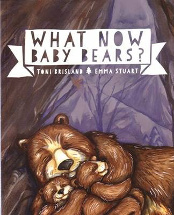What now baby bears? by Toni Brisland

Ill. by Emma Stuart. Little Steps, 2013.
All through spring, summer and autumn the baby bears frolic and
played in their beautiful, unspoiled environment. They ate
dandelions, and nuts and crowberries; they snoozed; they caught fish
and did what baby bears are supposed to do. In late autumn when the
trees swayed in the creek and the smell of snow was in the air, the
bears just knew it was time to find a den and sleep throughout the
winter. As the snows fell, they slept and slept and slept.
But when they woke, something strange had happened to their world.
There were houses and humans and a busy road ran through the forest.
So much of what they had known had gone, including the other baby
animals and the eagles. There was just one flower in sight - on the
other side of the busy road and disaster strikes when Mother Bear
crosses the road to fetch it. What will happen to the baby bears
now?
What Now Baby Bears? is Toni Brisland's first picture book
although she has more in the pipeline as well as two novels about a
Sherlock Holmes-like cat called DemiChat . Illustrator,
Emma Stuart has accompanied the text with delightful illustrations
which bring the bears to life and which characterise that cuteness
and cheekiness we associate with baby bears.
This story would be a great introduction to a unit about the impact
that humans have on the landscape and the flora and fauna within it.
Living where I do, the sight of fatally wounded wildlife on the side
of the highway is too common and if not for the efforts of
organisations like LAOKO the
toll would be higher. So even though this story is set in Canada,
inspired by the author's visit to a sanctuary for orphaned bears in
Vancouver, it has immediate relevance and would fit well within the
sustainability strand of the Australian Curriculum. While the
students' have little sway with politicians and town planners,
nevertheless there are always things that can be done through the
local wildlife organisations which could lead to a deeper
understanding of this critical environmental issue.
What Now Baby Bears? got a two-thumbs-up from the class I
shared it with, as well as a lot of discussion which was initially
less confronting because its characters were not the Australian
wildlife they saw every day. But it wasn't long before they made the
connections and started to consider the real story behind the baby
wombats that they see being cared for in the library from time to
time. Then they were keener than ever to create posters to try to
educate motorists as the annual ski season draws near and the danger
to our creatures increases.
Barbara Braxton